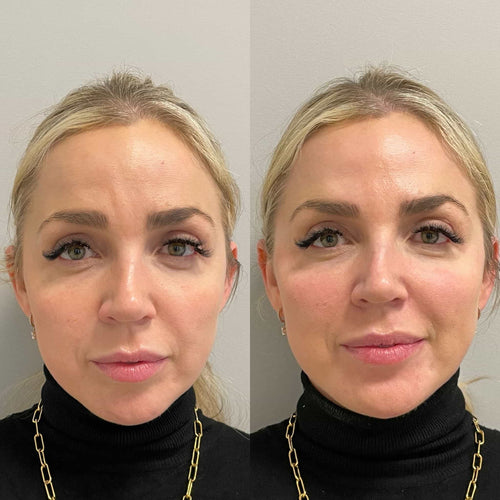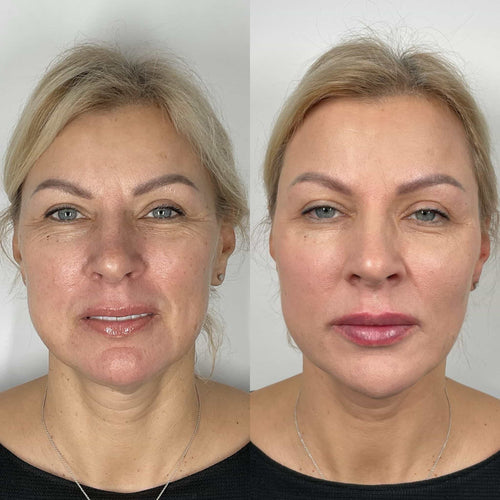Reserve Your Dermal Filler Consultation with Dr. Laura Geige Now
The Initial Swelling Phase
Immediate Results
The initial swelling phase typically lasts for several days following a lip filler treatment.
During this time, it’s common to experience noticeable puffiness and volume increase in the treated area.
This swelling is a natural response to the injection and can vary in intensity from person to person.

It’s important to note that the initial swelling masks the true result of your lip filler treatment.
You won’t see the final, settled shape and definition until the swelling subsides, usually within 1-2 weeks.
This means any “immediate results” you observe are temporary and may not accurately reflect the long-term outcome.
First 24-72 Hours
The initial swelling phase following lip filler treatment is a completely normal and expected part of the healing process. It typically peaks within 24-72 hours after injection.
Here’s what to expect during this time:

-
Swelling: The treated area will experience noticeable swelling, which may extend beyond the actual filler placement. This is caused by the body’s natural inflammatory response to the injection.
-
Tenderness and Pressure:** Lips may feel tender to the touch and slightly pressurized.
-
Bruising: Some light bruising may occur, particularly at the injection sites.
-
Changes in Lip Shape and Volume: Due to the swelling, lips may appear larger than intended. This is temporary and will subside as the inflammation resolves.
It’s important to follow your injector’s post-treatment instructions carefully during this phase. This may include:
Book a Dermal Filler Consultation at It’s Me and You Clinic with Dr. Laura Geige
-
Applying ice packs to reduce swelling.
-
Avoiding strenuous activity and heat.
-
Keeping lips hydrated with gentle lip balm.
-
Avoiding touching or picking at the injection sites.
Get Started with Dermal Fillers – Book with Dr. Laura Geige
Remember, swelling typically begins to subside after 72 hours and will continue to decrease over the following few days. Your final results will become more apparent as the swelling resolves completely, usually within one to two weeks.
Gradual Reduction
Immediately after lip filler injections, the treated area will undergo a period known as the initial swelling phase**. This swelling is a natural physiological response to the introduction of any foreign substance into the body.
During this phase, which typically lasts for a few days (sometimes up to a week), the lips may appear noticeably plumper and more pronounced than the desired outcome.
The extent of swelling can vary depending on factors such as the amount of filler used, the individual’s metabolism, and their sensitivity to injections.
While it might seem counterintuitive, the initial swelling is essential for achieving optimal results. It helps distribute the filler evenly throughout the lip tissue, creating a smoother and more natural appearance once the swelling subsides.
Following the initial swelling phase, there will be a **gradual reduction** in puffiness as the body begins to absorb excess fluids and the filler settles into its final position.
Over the following week or two, you’ll notice your lips gradually returning to their more normal appearance, but with a subtle enhancement of volume and definition.
This gradual reduction allows for fine-tuning and adjustment as needed. It ensures that the final result is aesthetically pleasing and aligns with your desired outcome.
Peak Perfection Timeframe
Reaching Full Effect
The timeframe for lip fillers to reach their peak perfection varies depending on several factors, including the type of filler used, individual healing processes, and injection techniques.
Generally, most people experience optimal results within two weeks after their treatment.
Here’s a breakdown of the timeline:
-
Day 1-3: Initial Swelling and Tenderness
-
Day 4-7: Peak Swelling; Results May Appear Overly Voluminous
-
Week 2: Most Swelling Subsides, Natural Appearance Emerges
-
Week 4: Final Results Manifested; Full Effect Achieved
Individual Variability
Peak perfection timeframe for lip fillers varies depending on a multitude of individual factors. It’s not a one-size-fits-all scenario.
Here’s a breakdown of what influences the “peak” and why it can differ:
1.
Type of Filler Used
Different fillers settle at different rates, leading to varying peak times. Some fillers are hyaluronic acid-based and plump immediately, while others may take days or weeks to fully integrate.
2.
Individual Metabolism
Just like how our bodies process food differently, our metabolism plays a role in how quickly filler is absorbed and distributed. Faster metabolism might lead to a quicker “peak” but also a shorter duration of results.
3.
Injection Technique
The skill of the injector significantly impacts the outcome. Precise placement and depth affect how the filler settles and ultimately influences the peak appearance.
4.
Lip Anatomy
Everyone’s lips are unique in terms of shape, thickness, and volume. These anatomical variations influence how filler interacts with the tissue, affecting the time it takes to reach its optimal look.
5.
Skin Elasticity
Younger skin tends to bounce back more readily, resulting in a quicker “peak” after fillers are injected. As we age, skin elasticity decreases, which can extend the timeframe to achieve maximum plumpness.
Generally, most people see noticeable improvement within a few days, with peak results appearing around 2 weeks after treatment. However, individual timelines can deviate significantly from this average.
The best way to understand your specific timeframe is to have an in-depth consultation with a qualified aesthetic professional. They can assess your individual needs and provide personalized expectations.
Factors Influencing Timing
Peak perfection time for lip fillers typically occurs around 2 weeks after treatment.
During the first week, swelling and bruising may be prominent, obscuring the final shape and volume achieved by the filler.
As these initial side effects subside over the subsequent days, the lips begin to settle into their new form.
By the second week, most of the swelling has diminished, revealing the desired lip enhancement.
Several factors can influence the exact timeframe for peak perfection:
**Filler Type:** Different filler formulations have varying degrees of swelling potential and absorption rates. Hyaluronic acid fillers tend to cause less swelling than volumizing agents like silicone.
Treatment Technique: The injection technique used by the practitioner can also impact swelling. Experienced injectors are skilled at minimizing bruising and maximizing precision, leading to a quicker recovery.
**Individual Healing Rate:** Every person’s body responds differently to injections. Some individuals heal quickly and experience minimal downtime, while others may require a longer period for full resolution of swelling.
Lip Anatomy: The thickness and structure of the lips can influence how they react to filler. Thinner lips may take slightly longer to settle than fuller ones.
**Lifestyle Factors:** Smoking, alcohol consumption, and certain medications can affect healing time and potentially prolong swelling.
Long-Term Maintenance and Touch-Ups
The Lasting Impact of Fillers
Long-term maintenance and touch-ups are crucial for maximizing the longevity and impact of lip filler results.
Here’s a breakdown of what to expect:
-
Initial Results: Lip fillers typically start showing their full effect within a few days as the swelling subsides.
-
Gradual Degradation: Over time, hyaluronic acid fillers (the most common type) are gradually broken down by the body’s enzymes.
-
Duration Varies: The lifespan of lip fillers depends on several factors, including the specific filler used, individual metabolism, lifestyle, and sun exposure. Generally, expect results to last anywhere from 6 months to 18 months.
Touch-Up Appointments:
-
Schedule Regular Boosters: To maintain optimal volume and definition, most patients opt for touch-up appointments every 6-12 months.
-
Enhance Existing Results: Touch-ups can be used to subtly refresh the lips, address any slight asymmetries that may have developed, or add additional fullness if desired.
Factors Influencing Longevity:
-
Filler Type: Some fillers are formulated for longer-lasting results than others.
-
Placement Technique: Precise injection placement can help extend the life of the filler.
-
Sun Exposure: Excessive sun exposure can break down hyaluronic acid, leading to faster degradation.
The Lasting Impact:
Lip fillers can provide a transformative boost to facial features. Over time, regular maintenance can lead to a more youthful and balanced appearance by enhancing lip volume, definition, and symmetry.
Replenishing Volume Over Time
Long-term maintenance of lip fillers involves touch-up appointments to replenish volume that naturally diminishes over time. Most individuals see a reduction in filler volume within 6 to 18 months, depending on factors like metabolism, lifestyle, and the type of filler used.
Replenishing volume periodically can maintain your desired lip shape, size, and fullness. Touch-ups typically involve injecting additional filler into areas that have lost volume, enhancing symmetry and restoring a youthful appearance.
The frequency of touch-up appointments varies based on individual factors. Some people may need touch-ups every 6 months, while others can go up to 18 months or more between treatments.
During your initial consultation with a qualified injector, discuss your expectations and desired longevity. They will assess your unique anatomy and skin type to recommend an appropriate maintenance schedule.
Staying hydrated and avoiding excessive sun exposure can help prolong the results of your lip fillers. A healthy lifestyle also contributes to maintaining facial volume over time.
Maintaining Natural Appearance
Maintaining the longevity and natural appearance of lip fillers requires a commitment to long-term maintenance and occasional touch-ups.
Here’s a breakdown of how to keep your lips looking their best:
-
Regular Touch-Ups: Lip filler results gradually fade over time, typically lasting 6 to 18 months. Schedule touch-up appointments with your injector every 6-12 months to maintain fullness and volume.
-
Sun Protection: The sun’s ultraviolet (UV) rays can break down hyaluronic acid, the main ingredient in many lip fillers. Consistently wear a broad-spectrum sunscreen with an SPF of 30 or higher on your lips to protect them from sun damage.
-
Hydration: Dehydration can make lips appear thinner and accentuate any fine lines, making the filler less noticeable. Drink plenty of water throughout the day to keep your lips plump and hydrated.
-
Gentle Lip Care:**
-
Avoid using harsh lip scrubs or exfoliating agents, as these can irritate and damage the delicate skin on your lips.
-
Choose lip products that are formulated to be moisturizing and hydrating, such as balms, serums, and conditioners. Avoid drying ingredients like alcohol and menthol.
-
Avoid Picking or Licking Lips:**
-
Picking at your lips can damage the filler and cause uneven results. It also increases the risk of infection.
-
Licking your lips further dehydrates them, making filler less effective.
-
Healthy Lifestyle: Eating a balanced diet rich in fruits and vegetables provides essential nutrients for skin health. Getting enough sleep and managing stress levels also contribute to overall skin wellness, including lip appearance.
By following these tips, you can extend the lifespan of your lip fillers and maintain a natural, youthful look for longer periods.
My Mental Health Rocks Christina Stambolian Derwen Roots Zoe Mallett Coaching
- Upper Face Anti Wrinkle Treatment Near Stoke D’Abernon, Surrey - January 3, 2025
- When Do Lip Fillers Look Their Best? - December 19, 2024
- Feather Details: The Latest Lingerie Trend Taking Over - December 14, 2024
